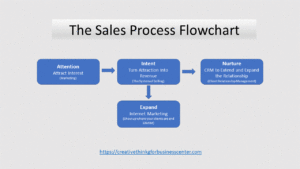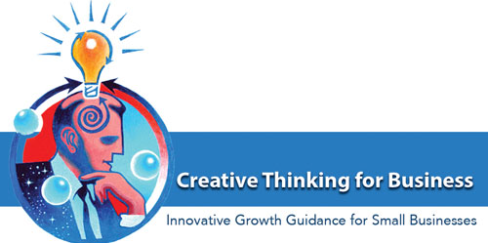The process to create revenue for a business is focused on the sales process. The challenge is that most small business owners see the sales process as one element; sales.
The sales process flowchart will demonstrate that the sales process encompasses all of the aspects of business building.
A complete sales process includes:
Attracting interest into your sales pipeline with marketing.
Selling by serving those people who expressed intent consistently through your system of selling.
Maintaining and building relationships with every new client through your client relationship management or CRM system.
Using internet marketing strategies to create a cycle that consistently keeps your sales pipeline full.
No matter what industry you’re in, the sales process remains consistent.
After reading this article, I encourage you to create a plan for each step that I’ll describe below.
Then follow the plan consistently.
When you have the opportunity to service a client, treat that client as a member of your extended business family. Without that client’s trust in your business, you have no chance to grow and prosper long-term.
When you create a plan using the sales process flowchart steps below and follow it consistently, you’ll find that every business interaction, from start to finish, will reap significant benefits and ongoing value for your business.

Step # 1 Attention. Attract interest to your offer or marketing
The good news is, your business may be able to help numerous people or businesses.
The bad news is when you try to help everybody, you end up helping no one.
The reason is, the masses dilute your message. Too many other messages are out there competing to attract the attention of “everybody”.
The fact is, you can only help a person (or company) who embraces similar values to you. Your value is the foundation of your business. The people you serve will be like-minded with similar values to yours.
Notable business author Seth Godin, in his breakthrough book, This Is Marketing, inspires us to ask two simple questions to understand better the people you can best serve and the value your business delivers.
Question one is, who’s it for?
In other words, what is the mindset and values of the person who gets the most value and is the biggest fan of your business and the service or product you deliver?
These are the people you want to talk
to in marketing. What do they believe? What do they value? What group/belief are they proud to be associated with?
The core values your prospective clients embrace is essential because all of the marketing you deliver needs to talk to this narrow group of individuals.
After you discover who your business offering is for, the next question to ask is what, as in what’s it for?
What is the purpose of your business? What value do you always promise to deliver, no matter what?
Identifying the ‘what’ factor behind your business is not always easy. You take what your company does for granted because you work in it every day.
However, seeing the business through the eyes of a new client will allow you to gain a new view of your business.
In working with clients, I find that asking “what’s it for” opens the door to new services that enhance and expand the profitability of the company.
Once you discover the who and what of your business, it’s time to start marketing.
Focus on educating. Prospective clients are searching for information, all the time. When they find information that you and your business provide and see that information as helpful, you establish trust leading to triggering interest and buying intent.
Think of it marketing as, “Educate to advertise” about the value your business offers.
No matter what business you’re in, you are the expert. You know the ins-and-outs of your business so well, you probably take your expertise for granted.
Remember, you know more about what you offer than any prospective client searching for information on the service or product you offer. Share that knowledge as your best marketing tactic.

Step # 2 Intent. Turn attraction into revenue or the system of selling (sales)
Sales is the mainstay of every business. Without revenue, you have no business. To generate revenue, you use a sales system.
In the attraction phase, marketing attracted interest from a prospective client. It has done its job. Now it’s up to the sales system.
Of all the topics in business, sales is one of the most dreaded. Why? The reason is that that people see selling as ‘convincing’ someone to buy from you. If they don’t, business owners take it personally and feel rejected.
The challenge here is that business owners misunderstand sales. Selling is not convincing or win/lose.
Selling is nothing more than serving the needs of a prospective client. You offer to help with a problem the prospect has identified having. You educate and recommend. The client decides if that’s the kind of help they need.
When you deliver value that fills a client’s need, you have a new client.
If what you offer is not what the clients see as needed, you can help them find another resource that may provide a different solution. By providing a different resource that may be a better fit you become memorable to that prospect.
At worst, you have built goodwill and become memorable for future needs.
At best, you turned attraction into revenue.
When you’re “selling” start with the mindset of, “How can I serve the best interest of this person?” They have trusted you with their time. Make it worthwhile for them.
From first-hand experience, I can tell you that nothing feels better than working with people who know, like, and trust you. When clients become extended family, your business takes on a new dimension.

Step # 3 Nurture. Client Relationship Management (CRM) expands the relationship
Once you’ve completed a project and ensured complete satisfaction, the next step of the sales process kicks in.
Start by ensuring complete satisfaction. Years ago, I learned a simple process from sales expert Michael Goodman that I use to this day. His method ensures your client sees that you reached their goals in a project.
You can do that at the end of every project. Ask your client:
- Did I keep every promise I made?
- Did I deliver the result that I promised I would?
- Are you 100% satisfied with the outcome of our project?
Once you know you delivered complete satisfaction, it’s time to nurture the relationship.
Do that by caring about your clients. Did you see a blog post or article online that made a client come to mind? Email the article.
Did you hear about a clients’ birthday, anniversary, or another life event on social media? Acknowledge them.
Did a client come to mind today, for no apparent reason? Call and tell them that and then ask how they’re doing.
Did you create a blog post or educational article that may help a group of clients? Send it to them individually, with a note telling them you thought they might enjoy it.
Nurture means caring. Caring takes commitment. Commitment builds relationships. Relationships lead to trust. Trust leads to repeat business, referrals, and great reviews.
If nurturing is not part of your sales process today, I’d encourage you to add it at once. The growth and vitality of your business depend on it.

Step # 4 Expand. Use internet marketing to stay visible to your prospective clients
Search online, and you’ll find thousands of websites that talk about internet marketing. It is mind-boggling and overwhelming.
Let’s break it down to what internet marketing is.
Internet marketing is nothing more than staying in front of your market by showing up where they are. Offer information that’s helpful to them (edutise). Provide support and answer questions to help them with the challenges they have.
When you do, your reward is prospective client interest. Attracting interest builds intent and opens the sales conversation.
Internet marketing is an important tactic to use that keeps your sales pipeline full.
The challenge is, internet marketing is a vast topic. I recommend that most businesses get help to accomplish their goals.
You can hire a well-vetted internet marketing expert, like
Mike Pedersen, for example. I like Mike’s work because he delivers a result. A verifiable result is his promise to every client he serves.
You can talk to Mike or find someone similar on your own. The key takeaway is, make sure whomever you use offering internet marketing services focuses on delivering results — meaning leads into your sales system.
The same with copywriting. Writing for business results takes time to learn. It takes continuous skills updating and expansion.
Here are a couple of tips for web copywriting.
Talk TO people and not AT them.
Write like you talk and don’t try to ‘write.’ Good news, you can toss the English class lessons out of the window. Talking on paper is writing today.
In my sales process development work, I help my clients with copywriting. If you have questions or if I can help you in some way I’m happy to connect with you. Leave a comment and let me know you’d like to talk.
Stay in front of your market online by delivering value. Content that offers ideas, advice, or how-to information can be helpful to a prospective client with a problem they want to solve.
Discover the social media platforms your clients often use and show up there.
When a new client comes on board, connect with them on the social media channel of their choice. That way, you’ll begin to learn where your clients are online so that you can focus on those channels consistently.
Create a blog on your website to ‘house’ the information you share. Then send people to your business blog to get one piece of specific information you think may help them resolve a challenge or provide the information they need.
That way, you’ll be helpful and have a convenient place for people to return to on their own.
I hope this helps you get started. Again, get the support you need to add internet marketing to your full sales process.
You can see 10% to 40% revenue growth per year, on average, with a robust online presence.

Putting Your Sales Process Together
We covered a lot of ground in this article.
Now you know that attraction is what marketing is all about.
Intent turns attraction gained in marketing to revenue through your system of selling.
Nurture to support, expand, and build relationships with every client you serve through your client relationship management or CRM system.
And using internet marketing strategies to create a cycle that consistently keeps your sales pipeline full is a significant area to focus on to increase revenue predictably every year.
Your next step is to evaluate where you are in each area by following the sales process flowchart I outlined in detail here.
Take note of the gaps in your sales process system.
Follow the direction in this article to build a bridge over your sales process gaps to create a complete, smooth running, revenue building sales process.
While it may sound intimating, take it one step at a time.
Step-by-step you’ll bridge one gap, then another and yet one more until you have a sales process that builds trust, relationships, and revenue for your business.
If you have questions on the sales process, I’m happy to answer them for you. Leave a comment below, and I’ll reply with an answer.

